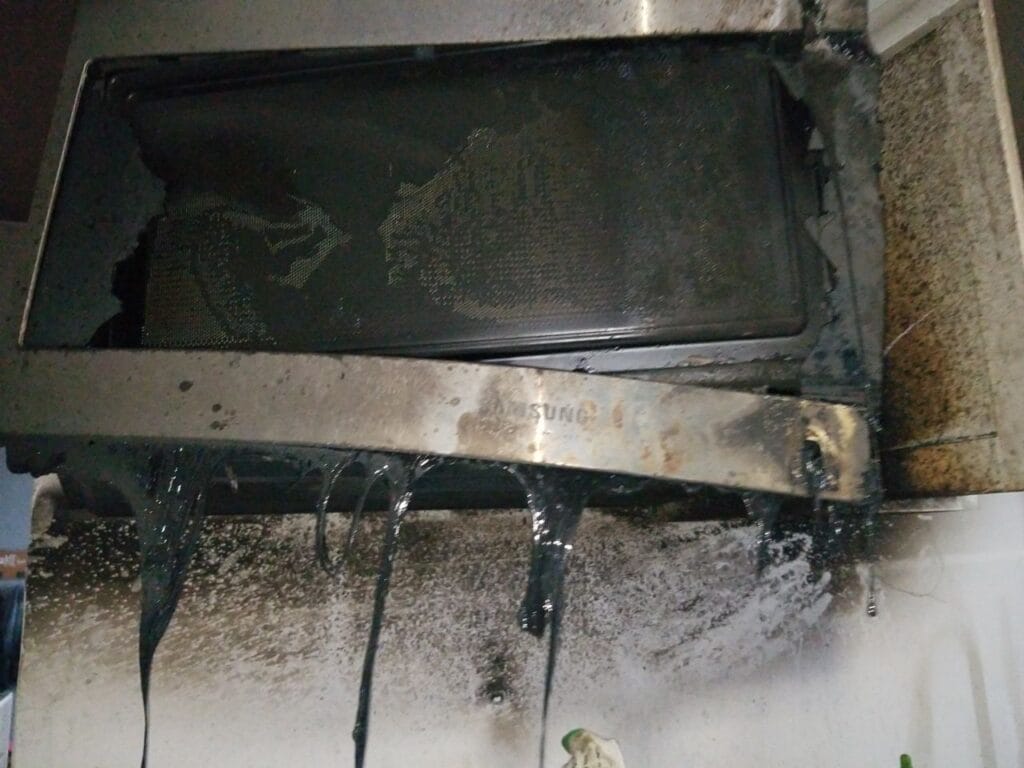Cooking at home can turn into a disaster in just a few minutes. A small grease splatter ignites, and you’re suddenly facing a kitchen fire. Once the flames are extinguished, you’re out of danger. Take a good look around.
Everything is covered with soot. Smoke damage stains walls, and overpowering odors hang in the air. Where do you start with kitchen fire cleanup?
If you’re going to tackle the mess by yourself, you need to know how to clean up after a kitchen fire. The wrong techniques can spread soot through the house, make stains permanent and even threaten your health.
Key Takeaways
- To clean up kitchen fire damage, gather your gear, open windows and doors to clear the air, clean surfaces thoroughly, use the right cleaning products, and clean the inside of your cabinets, drawers, and appliances.
- Even if the fire was contained to the kitchen, the whole home could have lingering smoke odors, so it’s important to clean all surfaces and take steps to remove smells.
- If you need additional help cleaning up kitchen fire damage, call a restoration company like ServiceMaster Restoration by Zaba.
How to Clean Up Kitchen Fire Damage

We’ve covered dealing with the aftermath of a home fire, but soot and smoke damage in the kitchen can be a real challenge. When we help residents here in Chicago recover from this kind of home disaster, we’re often asked for pointers on how to clean up after a kitchen fire.
If damages from soot and smoke aren’t extensive, you can take care of kitchen fire cleanup with a DIY approach. Follow these five tips – and make sure to read this FEMA guide – as you work, and always be careful to protect your personal safety and health.
1. Get Your Gear Together
Soot residue from a kitchen fire forms a greasy film that covers everything. The sticky stuff is composed of carbon-based particles that easily penetrate lungs, eyes and skin. Soot poses serious health risks, so protect yourself from contamination as you work by wearing a face mask, goggles and rubber gloves.
2. Start Clearing the Air
Open all windows and doors to the outside, and set up fans in opposite corners of the kitchen. You want to generate a strong crosscurrent of air that pushes out odors. Don’t run the AC while you clean because it will circulate contaminated air into your ductwork and all through the house.
Power Tip: If the HVAC system was on when the fire broke out, don’t forget to change out its filters with replacements rated between MERV 7 and MERV 12.
3. Clean Surfaces with Patience
Don’t expect to remove all soot from surfaces with one pass. Follow your first application of a cleaning product with a good rinse, let the area dry thoroughly, and clean again. This technique takes patience, but it makes the cleanup process more efficient. It also helps preserve finishes on walls and cabinets painted with semi-gloss.
Power Tip: Flat finishes usually have to be repainted after a kitchen fire, but they must be cleaned first. Otherwise, soot will stain through new primer and paint.
4. Match Cleaners to the Job
When we’re asked how to clean up after a kitchen fire, our customers often wonder which products are best for this type of work. We recommend these effective alternatives to ordinary household cleaners:
• Trisodium Phosphate – Mixed with water, industrial-strength TSP works very well on sticky soot residue. This is a strong product, so wear gloves, and avoid splashing. Don’t use it to clean ceramic tile or chrome fixtures.
• Degreaser Products – These cleaners aren’t as harsh as TSP, but they cut through soot film on all types of surfaces. Always check a degreaser’s specs to make sure it’s right for your cleanup job.
• Dry Soot Sponges – As long as you’re careful to completely rinse and dry soot sponges between each use, they effectively clean all surfaces including fabric. Dry sponge material is specially designed to remove residue without using water or liquid cleaning products.
5. Get Inside Cabinets, Drawers and Appliances
Closed doors are no defense against smoke and soot. Empty out cabinets, pantries and drawers, and toss all packaged food including everything in the refrigerator. Thoroughly clean shelves, walls and hardware. Check rubber gasket seals around appliance doors for any signs of damage, and be sure to clean condenser coils on the back of the fridge.
Freshen Up the Entire House
Even when flames are confined to the kitchen, your entire home is affected by lingering odors. To sum up our guide on how to clean up after a kitchen fire, we recommend these quick tips for freshening up the entire house.
- After you’ve removed all soot, clean non-porous surfaces with an orange citrus cleaner.
- Leave open coffee containers in closed cabinets to combat odors.
- Set out bowls of vinegar throughout the house to absorb lingering smells.
- Sprinkle baking soda on carpets, and let it set for several hours before running the vacuum.
- Call in a restoration company to set up ozone generating equipment that quickly freshens the air.
Dealing with the Aftermath of a Kitchen Fire in Chicago, IL? We Can Help

When you face kitchen fire cleanup by yourself, it can turn into a huge project. We hope our tips make the job a little easier. If you feel like the job’s too big, don’t try to face it on your own. Contact our teams here at ServiceMaster Restoration by Zaba.
As one of the most trusted Chicago fire restoration companies, we’re here to get your kitchen back to normal as quickly as possible. We restore your peace of mind too, and we’re here for you 24/7.
Call for 24 hour fire damage cleanup services in Chicago and suburbs: 773-647-1985
